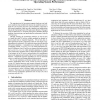50 search results - page 7 / 10 » Testing the Limits of Emergent Behavior in MAS Using Learnin... |
CEC
2010
IEEE
13 years 8 months ago
2010
IEEE
For any embodied, mobile, autonomous agent it is essential to control its actuators appropriately for the faced task. This holds for natural organisms as well as for robots. If sev...
ATAL
2009
Springer
14 years 2 months ago
2009
Springer
Certain observable features (tags), shared by a group of similar agents, can be used to signal intentions and can be effectively used to infer unobservable properties. Such infere...
TNN
2010
13 years 2 months ago
2010
Statistical learning methods are emerging as a valuable tool for decoding information from neural imaging data. The noisy signal and the limited number of training patterns that ar...
ISPASS
2007
IEEE
14 years 1 months ago
2007
IEEE
The ongoing trend of increasing computer hardware and software complexity has resulted in the increase in complexity and overheads of cycle-accurate processor system simulation, e...
CAI
2010
Springer
13 years 5 months ago
2010
Springer
Abstract. This paper introduces the model-based software development lifecycle model SMA--the Smyle Modeling Approach--which is centered around Smyle. Smyle is a dedicated learning...


